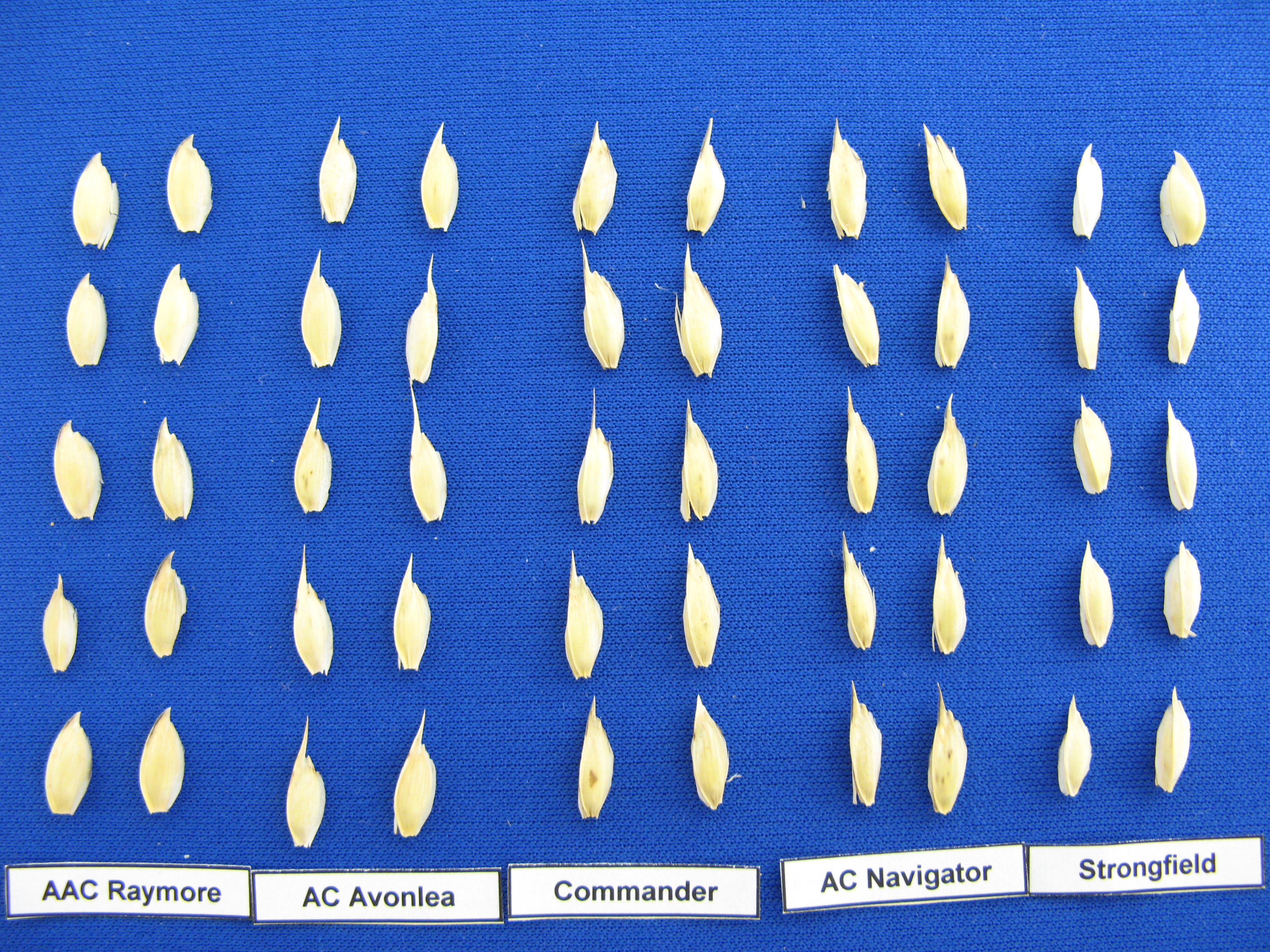AAC Raymore
| Denomination: | 'AAC Raymore' |
|---|---|
| Previously Proposed Denomination: | 'DT818' |
| Botanical Name: | Triticum turgidum subsp. durum |
| Applicant/Holder: |
Agriculture & Agri-Food Canada, Swift Current Research and Development Centre 1 Airport Road P.O. Box 1030 Swift Current, Saskatchewan S9H 3X2 Canada |
| Breeder: |
Asheesh K. Singh, Agriculture & Agri-Food Canada, Swift Current, Saskatchewan |
| Agent in Canada: |
Agriculture & Agri-Food Canada Office of Intellectual Property and Commercialization c/o Shannon Whyte 107 Science Place Saskatoon, Saskatchewan S7N 0X2 Canada Tel: (204) 999-9887 |
| Application Date: | 2012-04-30 |
| Application Number: | 12-7601 |
| Grant of Rights Date: | 2014-08-25 |
| Certificate Number: | 4860 |
| Date rights surrendered: | 2023-08-11 |
Variety Description
Varieties used for comparison: 'AC Avonlea', 'Commander', 'AC Navigator' and 'Strongfield'
Summary: The flag leaf of 'AAC Raymore' is shorter than that of 'Strongfield' and narrower than that of 'Commander'. In cross section, the straw pith of 'AAC Raymore' is thick whereas it is thin in 'AC Avonlea' and 'Strongfield' and medium thickness in 'Commander' and 'AC Navigator'. The spike of 'AAC Raymore' is longer than that of 'Commander' and 'AC Navigator' and shorter than that of 'AC Avonlea'. At maturity, the awns of 'AAC Raymore' are brown to black whereas they are white on 'AC Avonlea' and 'Strongfield'.
Description:
PLANT: erect growth habit at the 5 to 9 tiller stage, matures mid-season
SEEDLING: strong to very strong intensity of anthocyanin colouration of coleoptile, glabrous lower leaf sheaths and blades
FLAG LEAF: medium frequency of plants with recurved/drooping flag leaves, very weak anthocyanin colouration of auricles, strong glaucosity of sheath, glabrous blade and sheath
CULM NECK: medium to strong glaucosity, no curvature
STRAW: thick pith in cross section, no anthocyanin colouration at maturity
SPIKE: medium to strong glaucosity, tapering shape, dense, off-white to yellow at maturity, erect at maturity, sparse hairiness of convex surface of apical segment
AWNS: longer than length of spike, brown to black
LOWER GLUME: medium length and width, glabrous
LOWER GLUME SHOULDER: narrow, straight
KERNEL: amber colour, large, elliptical shape, angular cheek, short brush hairs, medium to wide width and medium to deep depth of crease
GERM: medium size, oval shape
DISEASE RESISTANCE: resistant to Leaf Rust (Puccinia recondita) and Stem Rust (Puccinia graminis f. sp. tritici), moderately resistant to Common Bunt (Tilletia caries, Tilletia foetida), moderately resistant to moderately susceptible to Leaf Spot (caused by Pyrenophora tritici-repentis and Mycosphaerella graminicola), moderately susceptible to Loose smut (Ustilago tritici), susceptible to Fusarium head blight (Fusarium graminearum, Fusarium species)
INSECT RESISTANCE: resistant to Wheat Stem Sawfly (Cephus cinctus Nort.)
Origin & Breeding History: 'AAC Raymore' (tested as DT818) was derived from the cross 9675-AP2/DT732// 'Strongfield' made in 2003 at the Semiarid Prairie Agricultural Research Centre, Swift Current, Saskatchewan. It was developed using a doubled haploid technique by the wheat-maize pollen system. In 2004, 139 doubled haploid genotypes from the population were grown near Swift Current and 214 genotypes were grown near Leeston, New Zealand, during the winter of 2004-2005. Selections were made based on disease resistance, plant height, straw strength and maturity. Of these, 137 genotypes were selected and harvested as seed source for agronomic trials in Canada. In 2005, 137 doubled haploid genotypes were grown near Swift Current, Regina and Indian Head, Saskatchewan, and Lethbridge, Alberta. Fifteen genotypes were selected for agronomic performance, disease resistance and end-use quality. The selected genotypes (labelled A0302&AJ060) were bulked and tested in the 2006 Durum Western A3 test grown at four locations in western Canada. Various disease reactions were assessed at various locations throughout the Prairie provinces. A0302&AJ060 was tested in the Durum B test in 2007, and in 2008 was entered in the Durum cooperative tests as DT818. It was evaluated in the durum cooperative test from 2008 to 2011.
Tests & Trials: Tests and trials were conducted at the Semiarid Prairie Agricultural Research Centre, Swift Current, Saskatchewan in 2010 and 2012. Plots consisted of 4 rows, each 3 metres long with inter-row spacing of 23 cm with 4 replications per variety arranged in an RCB design. There were 40 leaf and 20 spike measurements. Means are based on a two year average. Differences are significant at the 5% probability level based on LSD values. Disease ratings were provided through the Disease Evaluation team of the Prairie Recommending Committee for Wheat, Rye and Triticale, Prairie Grain Development Committee.
Comparison tables for 'AAC Raymore' with reference varieties 'AC Avonlea', 'Commander', 'AC Navigator' and 'Strongfield'
Flag leaf length (cm)
| 'AAC Raymore' | 'AC Avonlea' | 'Commander' | 'AC Navigator' | 'Strongfield' | |
|---|---|---|---|---|---|
| mean (LSD=1.8) | 21.0 | 22.5 | 22.3 | 19.3 | 23.9 |
| std deviation | 0.7 | 0.7 | 0.7 | 0.7 | 0.8 |
Flag leaf width (mm)
| 'AAC Raymore' | 'AC Avonlea' | 'Commander' | 'AC Navigator' | 'Strongfield' | |
|---|---|---|---|---|---|
| mean (LSD=1.5) | 14.8 | 15.2 | 16.5 | 14.5 | 16.0 |
| std deviation | 0.3 | 0.3 | 0.3 | 0.3 | 0.3 |
Spike length (cm)
| 'AAC Raymore' | 'AC Avonlea' | 'Commander' | 'AC Navigator' | 'Strongfield' | |
|---|---|---|---|---|---|
| mean (LSD=0.4) | 7.2 | 7.7 | 6.3 | 5.7 | 6.9 |
| std. deviation | 0.1 | 0.1 | 0.1 | 0.1 | 0.1 |
Click on image for larger view

Wheat: 'AAC Raymore' (bottom left) with reference varieties 'AC Avonlea' (bottom centre), 'Commander' (bottom right), 'AC Navigator' (top left) and 'Strongfield' (top right)
Click on image for larger view

Wheat: 'AAC Raymore' (left) with reference varieties 'AC Avonlea' (centre left), 'Commander' (centre), 'AC Navigator' (centre right) and 'Strongfield' (right)
Click on image for larger view

Wheat: 'AAC Raymore' (top) with reference varieties 'AC Avonlea' (centre top), 'Commander' (centre), 'AC Navigator' (centre bottom) and 'Strongfield' (bottom)
- Date modified: